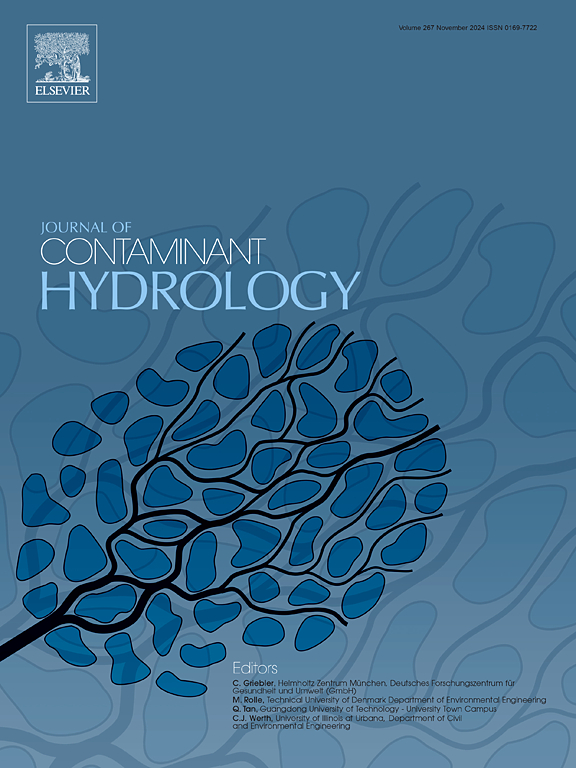Molecularly imprinted polymer with photocatalytic activity for ibuprofen adsorption, degradation, and detection in real water samples
IF 3.5
3区 环境科学与生态学
Q2 ENVIRONMENTAL SCIENCES
引用次数: 0
Abstract
The aim of this investigation was to synthesize molecularly imprinted polymers (MIPs) with photocatalytic activity for the treatment of the emerging pollutant ibuprofen (IBU).
The MIPs were synthesized by free radical polymerization; two different amounts of TiO2 were used (25 %w and 5 %w), and the synthesis followed a non-covalent method. IBU was chosen as the target. The functional monomer and the crosslinker were 2-vinyl pyridine and ethylene glycol dimethacrylate, respectively. Non-imprinted polymers were synthesized. All samples were analyzed using high-performance liquid chromatography. Adsorption and photodegradation assays were performed using the photocatalytic MIP. TiO2 does not affect the IBU adsorption capacity at concentrations below 20 ppm, however, the retention percentage is reduced at higher concentrations of TiO2. The pseudo-second-order model best describes the adsorption kinetics. The Freundlich model fits the adsorption process for all materials; KF is bigger for materials with 25 % TiO2. In laboratory assays, complete degradation of IBU was achieved within 2.5 min using a MIP with 25 % of TiO2. The presence of a possible degradation product is discussed. MIP/25 %TiO2 was chosen to be tested with real samples; a concentration of 709 μg/L of IBU was found, and a degradation time of 10 min.

具有光催化活性的分子印迹聚合物对布洛芬在实际水样中的吸附、降解和检测
本研究的目的是合成具有光催化活性的分子印迹聚合物(MIPs),用于处理新兴污染物布洛芬(IBU)。采用自由基聚合法制备了mip;采用了两种不同量的TiO2 (25% w和5% w),采用非共价法合成。IBU被选为研究对象。功能单体为2-乙烯基吡啶,交联剂为乙二醇二甲基丙烯酸酯。合成了非印迹聚合物。所有样品均采用高效液相色谱分析。采用光催化MIP进行吸附和光降解实验。TiO2在浓度低于20 ppm时不影响IBU的吸附量,但TiO2浓度较高时,IBU的吸附率降低。拟二阶模型最能描述吸附动力学。Freundlich模型适用于所有材料的吸附过程;TiO2含量为25%的材料KF更大。在实验室分析中,使用含有25% TiO2的MIP在2.5分钟内实现了IBU的完全降解。讨论了可能存在的降解产物。选用MIP/ 25% TiO2进行实样品测试;检测到IBU的浓度为709 μg/L,降解时间为10 min。
本文章由计算机程序翻译,如有差异,请以英文原文为准。
求助全文
约1分钟内获得全文
求助全文
来源期刊

Journal of contaminant hydrology
环境科学-地球科学综合
CiteScore
6.80
自引率
2.80%
发文量
129
审稿时长
68 days
期刊介绍:
The Journal of Contaminant Hydrology is an international journal publishing scientific articles pertaining to the contamination of subsurface water resources. Emphasis is placed on investigations of the physical, chemical, and biological processes influencing the behavior and fate of organic and inorganic contaminants in the unsaturated (vadose) and saturated (groundwater) zones, as well as at groundwater-surface water interfaces. The ecological impacts of contaminants transported both from and to aquifers are of interest. Articles on contamination of surface water only, without a link to groundwater, are out of the scope. Broad latitude is allowed in identifying contaminants of interest, and include legacy and emerging pollutants, nutrients, nanoparticles, pathogenic microorganisms (e.g., bacteria, viruses, protozoa), microplastics, and various constituents associated with energy production (e.g., methane, carbon dioxide, hydrogen sulfide).
The journal''s scope embraces a wide range of topics including: experimental investigations of contaminant sorption, diffusion, transformation, volatilization and transport in the surface and subsurface; characterization of soil and aquifer properties only as they influence contaminant behavior; development and testing of mathematical models of contaminant behaviour; innovative techniques for restoration of contaminated sites; development of new tools or techniques for monitoring the extent of soil and groundwater contamination; transformation of contaminants in the hyporheic zone; effects of contaminants traversing the hyporheic zone on surface water and groundwater ecosystems; subsurface carbon sequestration and/or turnover; and migration of fluids associated with energy production into groundwater.
 求助内容:
求助内容: 应助结果提醒方式:
应助结果提醒方式:


